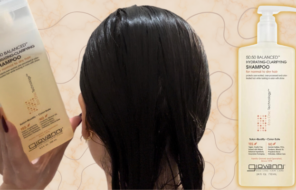Hair extensions are great pick-me-ups when you want to instantly add volume or length to your natural hair. But are they worth it? Learn everything about the types of hair extensions, how to apply and take them off, how to wear and care for hair extensions properly!
In this article:
- What Are Hair Extensions?
- Why Should You Wear Hair Extensions?
- Types of Hair Extensions
- How to Apply Hair Extensions
- How Long Do Hair Extensions Last?
- How to Remove Hair Extensions
- How to Care for Hair Extensions
- Pros & Cons of Wearing Hair Extensions
- Do Hair Extensions Damage Your Hair?
- Hair Extension Prices
- How to Make Your Hair Extensions Look Natural
What Are Hair Extensions?
The basic purpose of hair extensions is to make your hair longer. Either made of natural or synthetic hair, hair extensions help to add extra length to your hair and sometimes are called hair integrations.
Of course, they are of various types and durations, and the beauty they add is different. Depending on the type – synthetic or human (natural) – their costs vary. Obviously, human hair extensions would pull more off your pocket than synthetic counterparts.
Why Should You Wear Hair Extensions?
We advise you read carefully and digest. As much as you admire hair extensions, you should have reasons for wearing them. The reasons for wearing hair extensions are quite a few, and we will talk about a fraction of the few; you determine the rest.
- Color
- Length
- Volume
- Bangs
Those are the general reasons but for more important reasons, the hair extensions can help:
- To change your look from the short to mid-haired princess to the long-haired goddess.
- To increase the length and volume of your hair if your hair growth or thickness is poor.
- To change the look of your hair without chemicals and trims.
Depending on the personality, your preference for hair extensions might be to change your look on a short-term basis (like from morning to evening) or in the long term: probably months.
Nevertheless, some assume hair extensions are for ladies in the showbiz. If you do, that is a very wrong perception. For you to have a second thought about hair extensions as a thing for the public figures, below are some benefits of wearing hair extensions:
- You can easily clean and care for extensions yourself, depending on your choice of extension and the guide you read… this is a comprehensive one.
- They are safe, and the maintenance is cheap and convenient. For one, tape-in hair extensions will not damage your hair. Besides, you can fix and remove them in a short while.
Types of Hair Extensions: Which Hair Extensions Are the Best?
The types of hair extensions are numerous, so let’s start with long-term extensions.
Tape-In Hair Extensions
Like a union of two like terms, some small strips of hair, called weft, are taped to the end of your natural hair. If done right, the tape will look less truly taped but like the real length of your hair. It should be perfectly intact for up to 5 months. And if you are blonde, this is the best type you should try.
Pros
- It is fast to apply, between 60-90 minutes.
- Strains are minimal because it extends to a wide area of your head.
- You apply tape hair extensions without using heat.
- And heat cannot damage this type of extensions.
- It looks as natural as possible.
- The duration should be more than six weeks.
Cons
- The adhesive used is water-sensitive until they are properly cured for 24-28 hours. This means you mustn’t sweat or wash your hair during this period; lest you damage the extension before it is even ready for use.
- If you love swimming, this is not the right extension for you.
- No hair product can be used with tape-in hair extensions; a hair product may cause an unwanted slip of the extension.
- With this type, tying your hair turns to a difficult job.

Sew-In Hair Extensions/ Hair Weaving
In the literal sense, this type of hair extension is woven. First, horizontal cornrows are created in your hair. At the end of the cornrows, the extensions are sewn with needles. Thick hairs, the type African women are blessed with, are perfect for this type, as it hides the extension well enough.
Pros
- This is the best hair extension for short-haired ladies.
- No heat or glue needed.
- You can apply any hair product (for example, silicone and hair oils).
- Use for three months and the extension is still alive.
- It presents a natural look by concealing the gaps.
- It brings volume to your hair.
Cons
- When it is time to remove, you will mostly need professional help.
- Don’t try it if your hair is fine.
- Braids are usually tight; this can cause either scalp pain or traction alopecia.
- You need rigorous washing to prevent bacterial infections.
- The present cornrows, which should be hidden, reduce the styling options.
Hot Fusion/ Bonded Hair Extensions
This is one of the strand-by-strand hair extension methods. This style needs a keratin U-tip bond, silicone and – yes – the effort of a professional stylist. Your stylist, in this case, will use heat to fuse a keratin-based polymer to your hair. Keratin bond is attached with silicone and used on the extension, then, it is bonded to the roots of your hair.
Pros
- Depending on you, your maintenance and care, it can last up to six months.
- Extension joins uniquely to your hair by leaving no trace of an attachment, mainly because of the way keratin glues to the hair.
Cons
- Discomforts, such as a headache or itching, are possible.
- It requires a long hour to fix. Depending on a number of factors, fixing can take up to eight hours.
- You cannot use this hair extension twice.
- Professionals are the best to fix this extension to avoid serious damage to your hair.
Cold Fusion Hair Extensions
This type of extension is quite similar to the hot fusion extension, only in this case no heat application is required, since the extension comes with a keratin-based polymer that simply needs to be attached to the hair roots.
Pros
- While it takes 4-6 hours to be applied, it lasts 2-3 months, if you take a good care.
- It looks super natural, as it’s applied as close to the hair roots as possible.
- It doesn’t damage your natural hair a lot, since no heat application is involved.
Cons
- You can’t reuse this type of hair extensions.
- You may get some hair breakage because of the clamping tool.
- Headaches or scalp irritations are common for a few days after the application.
Micro-Link/ Micro-Ring Hair Extension
Micro ring hair extensions are available in small bundles of hair. They are encircled to small sections of the user’s hair, and after encircling, the extension is clamped with a metal bead and perfected using a pair of pliers.
There are other versions of hair extensions that do not require loop tools. They are already prepared with loops and beads.
Pros
- You do not need glue to attach this kind of extension.
- This hair extension can be straightened simply and used some other time.
- The blend with your natural hair is seamless.
- Adjustment is possible; slide them up or down to your desire.
Cons
- For those who have short or fine hair, please choose another type of hair extensions.
- It can cause some certain inconveniences, such as strain to the scalp.
- When it is time to remove, it can damage your hair.
- With this choice of hair extensions, you will not be able to rock high ponytails.
Clip-In Hair Extensions
Clip-in hair extensions are usually in small sets but sometimes appear as long swath that goes from one ear to another. The tiny combs are fixed to your hair roots; clip the extension to the roots of your hair in a short time. However, they really do not last long; by bedtime, they must be removed.
Pros
- It’s fast and easy to fix.
- You can use them on and off, like putting your clothes on and removing them.
- On a number of times, you can vary the colors for styling.
Cons
- It should be used for a short time, as clips can break or damage natural hair.
- By bedtime, you should remove clip-in hair extension.
- They are outrageously cheap, which means the quality is relatively low.
Glue-In Hair Extensions
As the name suggests, in this case small hair wefts are applied to the roots of your natural hair with the help of glue. This is a short-term hair extension method that will require the help of a stylist.
Pros
- It’s one of the most affordable temporary hair extension methods.
- It’s perfect for someone experimenting with hair extensions in the short term.
Cons
- Glue-in hair extensions do damage your natural hair when applied and removed inaccurately.
- If you accidentally apply the glue to the scalp, this can lead to bacterial infections.
- Headaches and even tension alopecia are common side effects.
- You need the help of a professional to apply these hair extensions.
- You have limited styling options, and it doesn’t last long either.
Wigs
Made either with artificial or natural hair, wigs are worn like hats covering your entire head. They are great for women with thinning hair or a bald scalp, but very often they are also used for styling purposes.
Pros
- Wigs are available in a number of colors and ready-made hairstyles, and you just need to wear them. From buns to braids to ponytails, you have your hairstyle ready to be shown off.
- You can put them on and take them off whenever you like.
- They don’t cause significant damage to your hair, like other types of hair extensions do, if you choose to wear them in the short term.
Cons
- Caring for wigs can be challenging, especially when it comes to washing them.
- You should wear a plastic onto which a wig is sewn, which can lead to changing your normal hair care routine, if you choose to wear a wig in the long term.

Human vs. Synthetic Hair Extensions
Regardless of the type, all hair extensions are made either with natural human hair or synthetic hair. For the former, real human hair is used, while for the latter synthetic fibers are used to create the extensions. They both are available in a myriad of styles and colors to match your natural hair and personality.
In terms of longevity, human hair extensions again win, since they can last for over a year. On the other hand, synthetic hair extensions will last a few months, depending on how you maintain them.
While human hair is the most expensive option around, it can also be treated like your natural hair: you can color and heat-style your human hair extensions like your own hair, and they always look more natural, seamlessly blending in with your hair. Natural human hair extensions are composed of virgin hair that hasn’t been colored or chemically treated.
Synthetic hair extensions are the most affordable alternatives and are perfect for rainy and humid weather conditions, since they never frizz or lose their shape. However, in this case you don’t have the freedom of styling your hair, since you can’t dye synthetic hair extensions, and if you try to heat-style, they are likely to melt. Moreover, artificial hair extensions look overly shiny, which makes telling them apart super easy.
How to Apply Hair Extensions
When it is time to apply hair extensions, all you need is to pick the right extension and read this section, as we look at two different methods that you can use depending on the hair extension type. With the hope that you will make the choice yourself, choose the most convenient.
So, let’s start… but before we do, there are some points to note:
- Pick the extension you want to use. Remember, natural hair extensions are preferable because they look natural. But artificial hair extensions are generally cheaper. Make a choice depending on this.
- Well, that is the first choice. You will have to make another choice of the type you want, either a clip-in or a fusion hair extension. Clip-ins, remember, are for a day use; clip in the morning, un-clip at night. Fusion needs heat to be fixed. Make another choice at this stage.
- If you choose a fusion hair extension, you will need a friend or stylist to get the best result. But it repays the effort with longevity; although it depends, you will use it for days and weeks.
And after choosing, let’s begin.

Applying Clip-In Hair Extensions
If you choose the clip-ins, you will be embraced by its simplicity in terms of application.
- Divide your hair into small sections.
- Part the sections where necessary.
- Create parts vertically above your ear and upward.
- Get hair clips to hold this section above your ear in position.
- Make another section at the back of your head, some inches towards the bottom.
- For the section behind your head, divide it into inches apart.
- Use rubber bands to hold the smaller sections apart at the root, an inch towards your scalp.
- Pick the best hair weft that will fit the section.
- If the clipped hair has only a clip each, use two wefts of clip-ins for the first section.
- Make it perfect by spacing the other section for about two inches apart.
- Open the clips of the extension.
- Attach to the root of the hair right where it is parted from your head and other sections.
- Snap the clip of the weft close.
- Brush through and you are done with this section.
- Create another section of hair above the completed.
- Divide it, like the first, into inches apart.
- Choose the size of clip-ins that you think will fit this bigger section.
- Apply.
- Brush through.
- Repeat the process again and again until you are done: make another section some inches above, divide into inches apart with a rubber band, and apply the right size of weft… now brush.
- If your hair is parted normally on the left or any other side, make sections to the side with most hair.
- For instance, on the section parted vertically above your hair, make smaller sections to the part that has most hair (this is usually towards the face).
- Rubberband just a section out of it.
- Pick a weft with just one clip and apply.
- Brush.
- Repeat the same for the other vertically parted hair above your ear.
And that is it; you are done lengthening your hair.
Applying Fusion Hair Extensions
Things you will need:
- Hair shampoo
- Brush
- Comb
- Fusion hair extensions
- Towel
- Cardstock
- Flat iron
The process goes as follows:
- Remove any residue, dirt or build-up that may disturb a perfect hair fusion; simply wash your hair with a clarifying shampoo. Use a towel to dry after washing.
- Use the bottom of a comb to divide your hair; the division of your hair in which the extension will be added… so it should be two inches wide, behind the head.
- Pick one of the extension strands and join to your divided hair; this should be as close to your scalp as possible.
- Now, the flat iron is needed to fuse the extension to your hair; for two to five minutes, use the flat iron to hold the end of your hair and the extension end together.
- Stop to relax for a minute, and then repeat the process.
- Blend the extension with your hair by rolling a finger into the joint of the extension and your natural hair.
- Continue the process around your head: divide, fuse and roll with a finger.
- After completing the process, brush.
And we are up. Your hair is now decked with fused hair extensions.
How Long Do Hair Extensions Last?
First thing first, one fact is certain: the more you wear your hair extensions, the shorter their lifespan becomes. Others factors assist in the maintenance of hair extensions (more about this below). But generally, each extension has its defined duration.
- Clip-ins have the shortest duration; morning to bedtime in most cases.
- Glue-in hair extensions last slightly longer – just a few days.
- Bonded and keratin hair extensions last for four weeks to six months.
- Tape-in hair extensions can last up to six weeks.
- Sew-in hair extensions last for up to eight weeks if properly maintained.
- You can enjoy your cold fusion extensions for 2-3 months.
- Micro-ring hair extensions can last 3-4 months before any touch-ups.
- Wigs can last an entire year when a proper care is involved.

How to Remove Hair Extensions
You have been looking beautiful for days, weeks, or months – in the case of a long-lasting hair extension. But one day, you will have to remove them – sorry!
But then, the joy is in applying a new one. This leads us to how you can get an extension off and not mess things up or worse, ruin your natural hair. And do you need to pull more than necessary out of your purse like a friend – a disseminator of bad news – has said by hiring a professional stylist?
Well, visiting a professional stylist is a good choice, but you can as well do it yourself by cautiously following our guide.
The method of hair extension removal depends on the type of extensions. The method you will need for a keratin-based extension will not work for a sew-in extension. Whichever the type, it can be removed with ease. So, let’s remove!
Removing Sew-In Hair Extensions
- Use your hand to group your hair into a ponytail.
- No. No. Do not try to differentiate the hair into two; instead, group it all as a ponytail.
- Using a comb, divide a small part of the ponytail into a section that you can handle at a time.
- Find the end of a sewn extension. Find the end of the thread and use a pair of scissors to separate the joint. Of course, you will need a mirror to find the sewn end.
- If your hair has grown over the sewn joint, there are a handful of options but you will have to cut some of your natural hair.
- Lose the thread gently and remove the hair extensions.
- In other cases, use salon products to remove the threads.
- After applying the salon product, comb out any debris.
- Repeat the process for all threads: find, remove, and comb.
- Wash your natural hair with a shampoo and hair conditioner.
Removing Keratin-Based Hair Extensions
A little information: keratins are stronger and more difficult to remove than sew-in hair extensions. Premade solutions or keratin removals are the best tools to simplify the process and achieve results.
However, we will give you two methods. Try the best.
- Use a large clip or a rubber band to hold your hair together.
- Out of the bunch, separate a small section you can handle out of the clip.
- Use nose pliers on the bond to squeeze and crack the bond.
- Gently and lightly twist the bond to remove it.
Another way:
- After you have separated the section you can handle at a time, wear a pair of rubber gloves – butyl rubber and latex are the best.
- Dip your fingers in acetone or oil (coconut, almond or olive oil).
- If you choose to use the oil, rub it on the keratin bonds, wait for 10-15 minutes and gently pull the extensions. You can also use a hair dryer on a low setting to speed up the process.
- If you instead decide to go with acetone, rub the bonds with your fingers until you notice it starts dissolving.
Or another – probably the best – way:
Keratin bond hair extension removals are available online and offline – just get one.
- Use them on the bond and wait for the stipulated timeframe.
- And it gets off as easy as melting ice.
Removing Tape-In or Glue-In Hair Extensions
- Pull all your hair together with a hair clip or a hair tie, and separate one section at the bottom, working your way up.
- Gently pull the extensions, trying not to be harsh in order not to damage your own hair.
- Apply hair oil on the extension bonds and wait for 15 minutes for it to function and break up the bonds from the glue.
- Now, wash your hair using a shampoo and then apply hair conditioner.
- Cover your head with a towel and wait for extra 20 minutes.
- Take off the towel and gently brush your hair to remove any remaining bonds that the oil couldn’t remove.
- Repeat the process several times to make sure you have thoroughly removed the extensions and the glue from each section of your hair. If at the end there still remains any glue, you’ll get rid of it in a few days as you wash and brush your hair.
Removing Clip-In Hair Extensions
Dealing with clip-in hair extensions is the easiest both in terms of their application and removal.
- To remove the clip-in hair extensions, make sure to unclip the hair wefts one at a time in order to avoid pulling your natural hair.
- After removing all the clips, gently brush your hair and the temporary extensions as well.
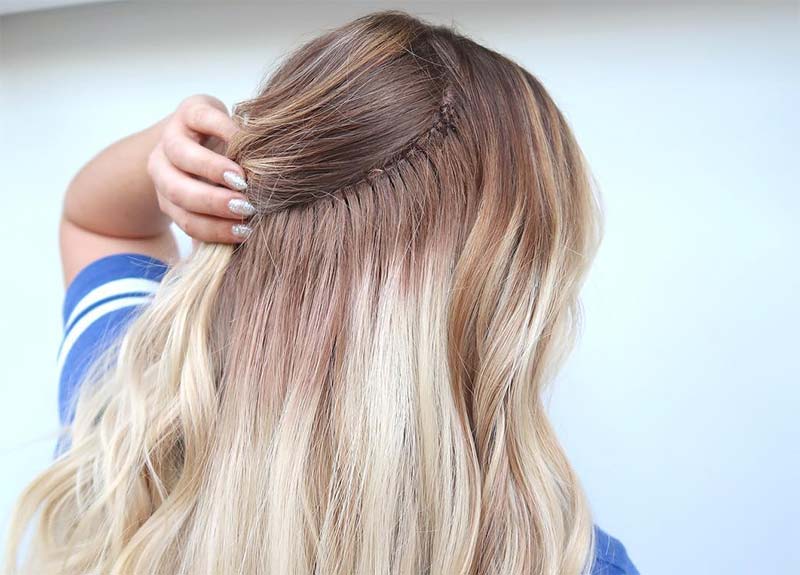
How to Care for Hair Extensions
What makes a hair extension last longer on one person than the other? Why does Miss Hygienic rock her extension for a month while Miss Filthy, with the same hair type, looks like a mess after a week?
The answer lies in the individual’s attention to hygiene and hair care. For hair extensions, the care and maintenance practices are quite easy to follow. This, of course, depends on you, the type, and the cost.
As you continue to wear your hair extensions regularly, the quality and lifespan depreciate. But not to fret, we will hand you the care process to keep your hair going stronger for as long as it could last. This is how to achieve that:
Caring for Clip-In Hair Extensions…
- Remove them before bed and brush them.
- When not in use, wash your hair extensions. This can be done monthly using a shampoo and conditioner. You should use a wig shampoo for synthetic hair extensions.
- Dry them gently with a towel and hang on a line to dry completely.
- Do not brush clip-in hair extensions while they are wet. And do not hang them out under the sun; try your room, a well-ventilated place, or your showers – these are the best places.
- When dry, use a wide-toothed brush to comb the hair only in one direction, from head to tail.
- Your hair should be dry when you are heat styling.
- Wear hair extensions as a ponytail if and only if your stylist or the direction says so.
- Fabric softener and water could work wonders. Pick a spray bottle and fill it with some fabric softener and water. When you are not wearing the extension, spray them and comb throughout. This will straighten the hair after so much frizzing, due to wearing for long.
Caring for Sew-In Hair Extensions…
- Use a hair shampoo to wash your hair every other day.
- Use a towel to pat your hair dry from the top to the root. It is necessary to keep the entire hair dry.
- If your sew-in hair extension is just a few days old, do not comb. This way, you will not damage your hair or injure your scalp.
- Use a hair conditioner on the sewn parts but use a moderate amount unless your hair starts falling out.
- Try not to heat-style your hair, and if you have to, always use a heat protectant spray.
- When you are up to bed, use hair nets. While you sleep, the net will keep the hair together – so, it will not frizz or become rough.
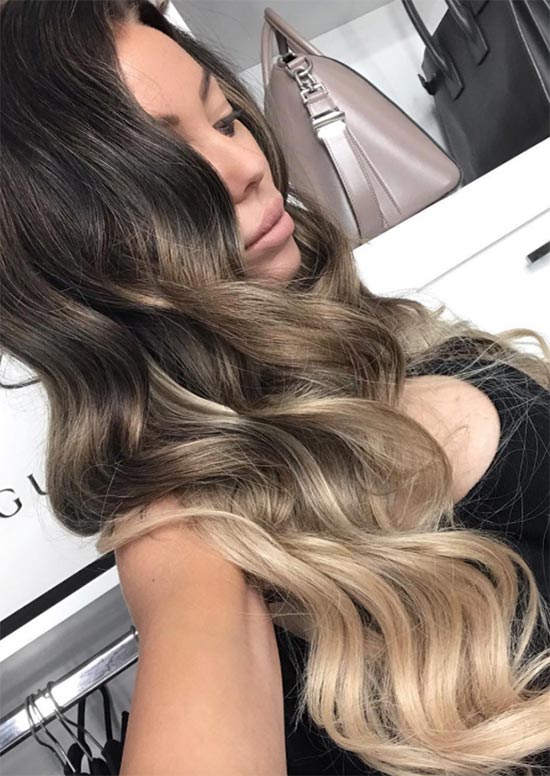
In General…
- Do not infuse the hair with chlorinated or salt water.
- Dry your hair completely before going to bed.
- Do not wash or style your clip-in hair extensions as often as you do other extensions.
- Because your hair does not have a natural source of hydration, rely on moisturizing the hair yourself.
- Store the extension in the cases they came in, if you do not have a storage box.
- Treat your natural hair extension as your hair, using a gentle sulfate-free shampoo and conditioner to wash it, and a loop brush to gently comb it.
- Tangling of hair is caused by friction between your hair and the extension. To avoid this, try not to sleep with an extension on. Or try to use a hair net and brush regularly.
- 2-3 drops of dry oil, like almond or coconut oil for hair, used once a week will give extra shine to your hair extensions.
- Shedding will happen as often as you brush. Some strands of the extension will loose, which is natural but to prevent losing more than expected, you should use them less often. However, shedding should not be controlled by failing to brush your hair.
Pros & Cons of Wearing Hair Extensions
Do understand that (almost) everything has its pros and cons. Similarly, no one would ever claim hair extensions exist without certain cons.
Now, let’s elaborate on the shortcomings of hair extensions so you can pronounce your verdict.
Actually, they are great because…
- They add volume and length to your hair. And as you are bedecked with extra hair length, you appear more beautiful.
- They come in different colors. You have a wide range to choose from. And we promise you will find as many colors as possible to go with your natural hair.
- You can have fun with hair extensions. Choose any color, length and tone. It is a matter of being creative.
However, they are awful because…
- If the weight of the hair extension is more than that of your natural hair, your hair will break off and fall out. In other words, your hair needs to be healthy and have the strength to use hair extensions.
- Glues, in complete honesty, are not friends with your hair. There are some horrors to their notoriety.
- Sewing will add weight to your hair, making it heavier – sometimes significantly.
- Sometimes the perfect hair is hard to find (but not if you follow a recommendation: use an extension type called HAIRDREAMS; it is available in highlights and lowlights, and in various thicknesses.).
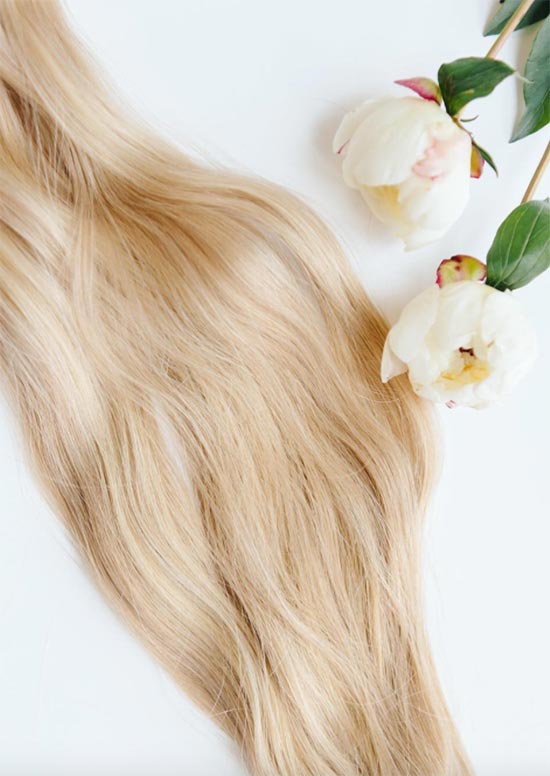
Do Hair Extensions Damage Your Hair?
You certainly do not want to go bald, and we understand. We do not support that as well. But what is all the news about glues and going bald? Do hair extensions really harm your hair: the growth, strength, thickness, lifespan, scalp, or any other thing?
Sadly, the news is true. If you use hair extensions, you might go bald… according to some dermatologists and hair specialists. But, there are other reasons other than just using glues.
Glues are said to cause too much tension on the hair root and eventually damaging the follicle. It is true, as you have read, but other factors contributed to that and not just the glues.
Basically, hair extensions cause damage depending on you, your stylist, and the method of maintenance.
If done properly, half (or more) of the risks are eliminated. This is why we have been advising you to hire a professional to help with the process.
Secondly, you as the carrier of the hair extension should follow our care and maintenance tips religiously and visit your stylist monthly for maintenance. Also, make sure your stylist is a certified or trained professional; sometimes it is better to do everything yourself than to hire a charlatan.
Further, the best hair extensions would be clip-ins. We would recommend it as the safest out of all. You add them during the day when you need them and remove them at night. No glues, nothing big – just add and subtract like mathematics. But if you do not like clip-ins, you need to read on.
All the talks about glues causing damages do not make sew-in hair extensions better. Sewn-ins add extra weight to the hair; this causes more stress and eventual damage to the hair follicle.
Here is a quick solution:
- When you are ready to fix hair extensions, see a real professional stylist.
- When you are feeling any form of pain due to the hair extension, still see a professional stylist, as she is to remove the extensions and reapply them.
- And when you are noticing gradual or rapid hair loss due to hair extensions, see a doctor.
Hair Extension Prices
We know you want to look like your celebrity hairstyle models but hey, they pay up to $4,500 for hair extensions. Can you afford that (if you can, you are in for a treat! If not, let’s move on.)?
Regardless of the type, hair extensions are not cheap. And even worse, an additional cost will be accrued when you consult a stylist or demand monthly maintenance.
Well, extra cost for professional service is relatable. In general, how much does a hair extension cost?
From the thickness to the length to the quality of hair extensions used, every factor greatly affects the costs of hair extensions.
The price ranges from $100 to $1,000 for the hair extension exclusively – excluding the monthly maintenance. A break down from a typical stylist says hair extensions begin at $275, and $60 for additional sewn tracks. Keratin bonds cost from $800 to above a thousand dollars, since 80-150 pieces of human hair strands are used in the process.
While 100% natural human hair is the most expensive type to get, for synthetic hair extensions, you might pay anywhere between $50-$100. However, in this case you can’t color or heat-style your hair.
The price range of woven hair is from $1,000 to $2,000, while cold fusion bonding can cost you between $1,000 and $3,000.
Clip-in hair extensions are the cheapest around, costing between $30 and $300, depending on the length, thickness and the hair quality.
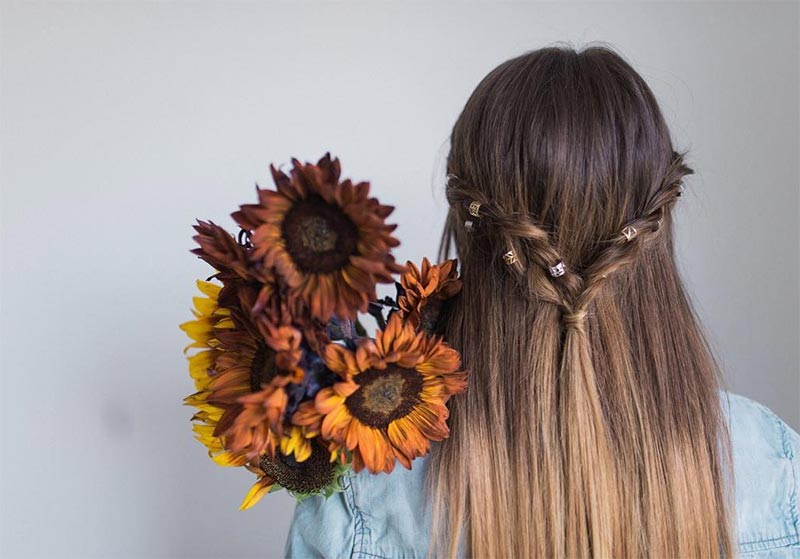
How to Make Your Hair Extensions Look Natural
What is the essence if someone could tell from a glance that you are wearing an extension? Well, some have eyes for spotting hair extensions but the truth remains: hair extensions can imitate the look of your natural hair. So, how do you get there?
To reiterate, there are two main types of hair extensions, and human hair extensions promise more natural look than synthetic extensions.
- Short hair extensions are the bomb. When the extensions are kept short, you stand a chance of tricking us. It will be a hard guess. Let the length of your hair determine the length of the extension.
- Take a lesson on seamless trimming. No, you are not going to a university to learn it. Just trim and trim and trim your hair extension to go with the natural hair length.
- Use curling rods to make curls along the length of the hair.
- Add colors. Change the tone of the clip-in extensions a little to assist it in blending more impeccably with your hair extension.
- Hair extensions come with a super glossy look. This makes it look more artificial than your natural hair. Nonetheless, the look will blend after washing.
- After fixing the extension, use a bristle brush – a sprayed one – to brush your natural hair.
- And before you step out, stop and check if everything is in order in a mirror.
Photos via @lacedhairextensions, Instagram


